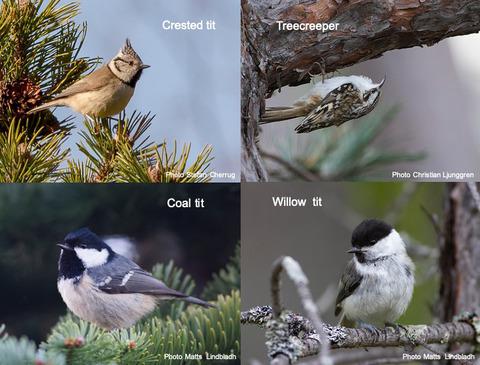当前位置:
X-MOL 学术
›
Anim. Conserv.
›
论文详情
Our official English website, www.x-mol.net, welcomes your feedback! (Note: you will need to create a separate account there.)
How generalist are these forest specialists? What Sweden’s avian indicators indicate
Animal Conservation ( IF 3.4 ) Pub Date : 2020-05-11 , DOI: 10.1111/acv.12595 M. Lindbladh 1 , P.‐O. Hedwall 1 , E. Holmström 1 , L. Petersson 1 , A. Felton 1
Animal Conservation ( IF 3.4 ) Pub Date : 2020-05-11 , DOI: 10.1111/acv.12595 M. Lindbladh 1 , P.‐O. Hedwall 1 , E. Holmström 1 , L. Petersson 1 , A. Felton 1
Affiliation

|
Monitoring of forest biodiversity and habitats is an important part of forest conservation, but due to the impossible task of monitoring all species, indicator species are frequently used. However, reliance on an incorrect indicator of valuable habitat can reduce the efficiency of conservation efforts. Birds are often used as indicators as they are charismatic, relatively easy to survey, and because we often have knowledge of their habitat and resource requirements. In the Swedish government’s environmental quality goals, there are a number of bird species identified as being associated with ‘older’ and ‘high natural value’ forests. Here we evaluate the occurrence of four of these indicator species using data from 91 production forest stands and 10 forest reserves in southern Sweden. The bird species assessed are willow tit Poecile montanus, coal tit Periparus ater, European crested tit Lophophanes cristatus and Eurasian treecreeper Certhia familiaris. For the production stands assessed, these indicator species exhibited no significant preferences regarding forest composition and structure, indicating a wider range of habitat associations than expected. These species frequently showed territorial behavior in forest stands <60 and even 40 years of age; much younger than the 120‐year threshold for ‘older forest’ as defined by governmental environmental goals. As almost 80% of the production stands ≥10 years old included at least one of the four indicator species, this raises questions regarding the suitability of these species as indictors of forests of high conservational value in southern Sweden. Notably, besides the four species assessed here, none of the additional indicator taxa identified by the government, were recorded in the 10 reserves. This outcome may reflect the difficulties involved in finding bird indicator species indicative of high natural values in this region. Our results highlight the importance of coupling bird surveys with quantified assessments of proximate vegetation cover.
中文翻译:

这些森林专家的通才如何?瑞典的鸟类指标显示了什么
监测森林生物多样性和栖息地是森林保护的重要组成部分,但是由于监测所有物种的任务艰巨,因此经常使用指示物种。但是,依靠不正确的有价值的生境指标会降低保护工作的效率。鸟类通常被用作指标,因为它们具有超凡魅力,相对容易调查,并且因为我们经常了解鸟类的栖息地和资源需求。在瑞典政府的环境质量目标中,有许多鸟类被确定与“较老”和“高自然价值”森林有关。在这里,我们使用来自瑞典南部的91个生产林分和10个森林保护区的数据评估了这四个指标物种的发生。评估的鸟类是柳雀珍珠褐煤,山雀角er,欧洲冠山雀Lophophanes cristatus和欧亚爬山虎Certhia熟悉。对于所评估的生产林,这些指标物种在森林组成和结构方面没有表现出明显的偏爱,表明生境协会的范围比预期的要广泛。这些物种在<60甚至40岁的林分中经常表现出地域性。比政府环境目标所定义的“老龄森林”的120年阈值要年轻得多。由于几乎80%≥10年的林分中至少包括四种指示物种中的一种,这引发了人们对这些物种是否适合作为瑞典南部具有高保护价值的森林指示物的疑问。值得注意的是,除了此处评估的四个物种外,在10个保护区中未记录有政府确定的其他指示生物分类。这一结果可能反映出在寻找表明该地区自然价值较高的鸟类指示物种方面所涉及的困难。我们的结果凸显了将鸟类调查与邻近植被的量化评估结合起来的重要性。
更新日期:2020-05-11
中文翻译:

这些森林专家的通才如何?瑞典的鸟类指标显示了什么
监测森林生物多样性和栖息地是森林保护的重要组成部分,但是由于监测所有物种的任务艰巨,因此经常使用指示物种。但是,依靠不正确的有价值的生境指标会降低保护工作的效率。鸟类通常被用作指标,因为它们具有超凡魅力,相对容易调查,并且因为我们经常了解鸟类的栖息地和资源需求。在瑞典政府的环境质量目标中,有许多鸟类被确定与“较老”和“高自然价值”森林有关。在这里,我们使用来自瑞典南部的91个生产林分和10个森林保护区的数据评估了这四个指标物种的发生。评估的鸟类是柳雀珍珠褐煤,山雀角er,欧洲冠山雀Lophophanes cristatus和欧亚爬山虎Certhia熟悉。对于所评估的生产林,这些指标物种在森林组成和结构方面没有表现出明显的偏爱,表明生境协会的范围比预期的要广泛。这些物种在<60甚至40岁的林分中经常表现出地域性。比政府环境目标所定义的“老龄森林”的120年阈值要年轻得多。由于几乎80%≥10年的林分中至少包括四种指示物种中的一种,这引发了人们对这些物种是否适合作为瑞典南部具有高保护价值的森林指示物的疑问。值得注意的是,除了此处评估的四个物种外,在10个保护区中未记录有政府确定的其他指示生物分类。这一结果可能反映出在寻找表明该地区自然价值较高的鸟类指示物种方面所涉及的困难。我们的结果凸显了将鸟类调查与邻近植被的量化评估结合起来的重要性。



























 京公网安备 11010802027423号
京公网安备 11010802027423号